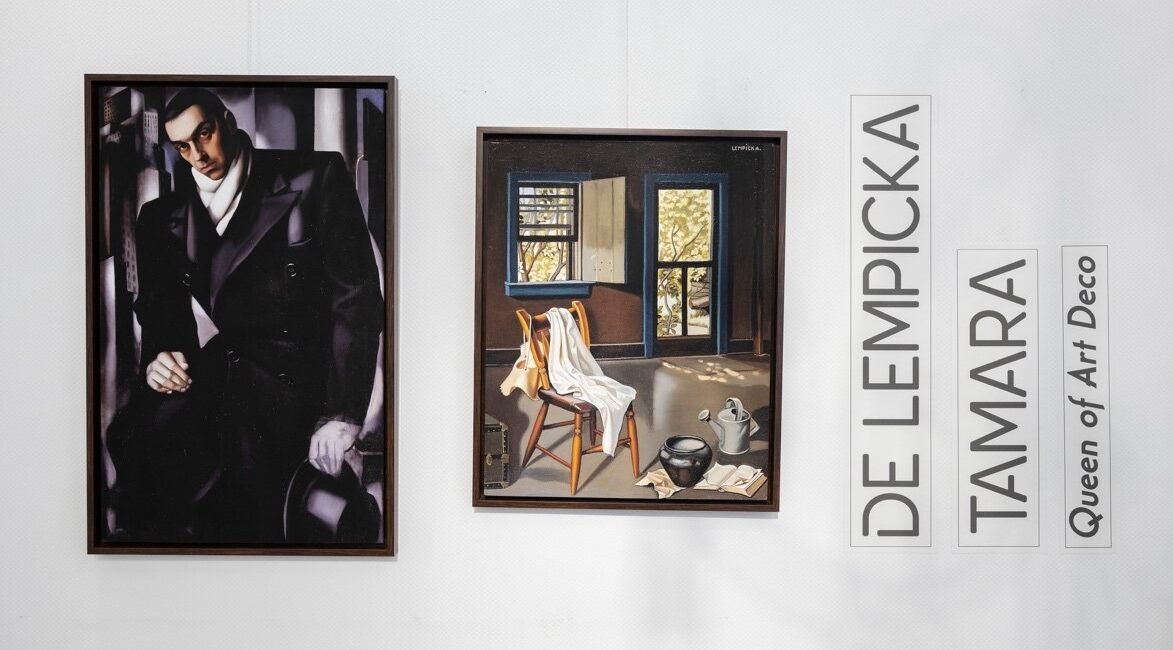In March 2025, Tbilisi hosted a rare cultural event. Tamara de Lempicka: Queen of Art Deco, presented by Vere Gallery in partnership with Reach Art Visual and the Polish Institute in Tbilisi, offered Georgian audiences a compelling opportunity to reconnect with one of modernism’s most iconic—and most enigmatic—figures.
The exhibition featured full-scale, officially licensed reproductions of Lempicka’s most celebrated works—including Self-Portrait (Tamara in a Green Bugatti) (1929) and Young Lady in Gloves (1930)—images that capture her unmistakable visual language: a blend of elegance, precision, and the cinematic flair that defined the Art Deco era.
Born in Warsaw in 1894, Lempicka remained deeply connected to her Polish heritage, even as she moved between the cultural capitals of Europe and America. Her life was shaped by upheaval and transformation—fleeing the Russian Revolution, building her career in Paris, and later relocating to the United States as war once again swept across Europe. There, she became famously known as “the Baroness with a Brush,” a moniker that captured her distinct persona as much as her self-fashioned identity.
Yet Lempicka was far more than a stylish icon. Her life stands as a testament to resilience and survival. In the United States, she actively supported efforts to aid war-torn Poland, contributing to the Paderewski Testimonial Fund and other charitable causes. In 1942, she joined the Women’s Emergency Corps, where she rose to the rank of Staff Sergeant and oversaw educational programs—sewing uniforms herself and inspiring others to contribute. As her granddaughter, Marisa de Lempicka, once remarked, “Even helping had to be done in style with her.”
In the conversation that follows, Ketevan Gorgadze, director of Vere Gallery, reflects on how this exhibition came together and how it speaks to Vere’s broader mission: connecting Georgian audiences with global art.

This exhibition marked your first collaboration with the Polish Institute in Tbilisi. How did that partnership come about, and how did it influence your approach to the show?
The partnership came together quite naturally, grounded in a shared desire to create something meaningful and relevant. We had worked with Reach Art Visual before, but this was our first time working with the Polish Institute. From the outset, it was clear that this would be more than a logistical arrangement—there was a genuine commitment to shaping a cultural event that would resonate with Georgian audiences.
Thanks to the direct support of the Polish Institute in Tbilisi and the Embassy of the Republic of Poland in Georgia, we were able to secure official authorization from the Tamara de Lempicka Estate to present full-scale, licensed reproductions of her most iconic works. That backing gave the exhibition both authenticity and institutional weight.

From the beginning, we agreed that this would not be a conventional retrospective. Instead, we wanted to frame Lempicka’s work as a dialogue—across time, geography, and identity. While her visual language is deeply rooted in the aesthetics of Art Deco, the themes she explored—self-image, control, and reinvention—remain strikingly contemporary. With the Polish Institute’s support, we were able to emphasize both her Polish heritage and her broader cultural relevance.
Lempicka is well known in Georgia. Did that shape the way you curated the show?
Absolutely. The existing familiarity allowed us to go beyond introduction—we could offer a deeper, more layered encounter with her work.
What drew us in was the tension between surface and substance. Her portraits, particularly of women, are confident and composed, yet always suggest something unspoken beneath the polish. That emotional depth mirrors her life story, which was shaped by upheaval, exile, and constant self-reinvention. You can feel the survival instinct in her brushstrokes.
Our visitors responded strongly to that complexity. They were not only admiring the aesthetics— they were reflecting on what these images meant in Lempicka’s time, and what they can still mean today. That level of engagement is what we always hope for: an encounter that sparks both admiration and reflection.


Vere Gallery often works to connect Georgian and international art. How does this exhibition fit into that mission—and what’s next?
This exhibition was very much in line with what we are trying to do at Vere: create meaningful exchanges between local and global artistic voices. Lempicka’s work carries the legacy of European modernism, but we were not just importing that history—we were asking how it might speak to people here, now.
We are continuing to build on that idea of exchange. We have plans to support Georgian artists in showing their work abroad, and we are always looking for ways to bring diverse international perspectives to local audiences through thoughtfully curated shows.
Looking ahead, our next focus will be on contemporary Georgian voices. We are especially interested in how artists here are responding to current cultural and social shifts, both locally and globally. There is much to look forward to.




No Comment! Be the first one.